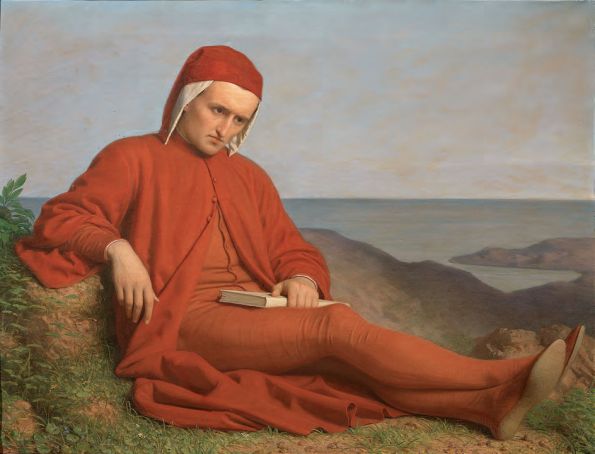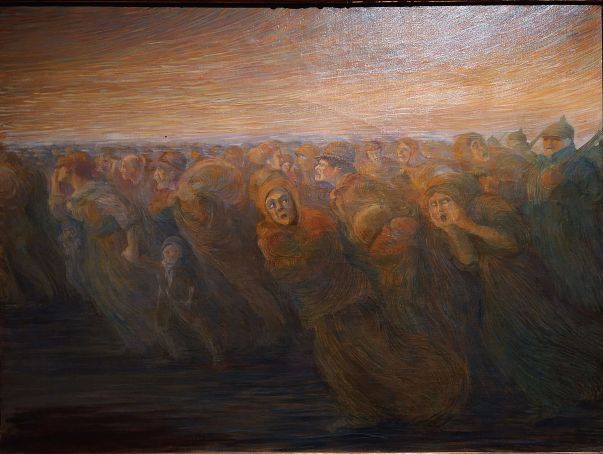Scuderie del Quirinale takes visitors on a hellish tour inspired by Dante's Inferno.
The exhibition Inferno at Scuderie del Quirinale, open until 23 January, marks the 700th anniversary of the death of Dante Alighieri. Coming shortly after the show on Raffaele, to mark the 500th anniversary of the painter's birth, this is another feather in the Scuderie's cap.
While the Raffaele exhibition had to shut because of the covid-19 lockdown, Inferno was organised during the pandemic. It is an impressive achievement that the curator and French art historian, Jean Clair, together with Le Scuderie del Qurinale, managed to put together 232 works, from 87 collections and 15 countries at a time when the world was effectively still in lockdown, or at least not working at its normal pace.
It is strange therefore that images of plagues and their various manifestations are nowhere to be seen in this exhibition. How many pandemics over the centuries have created their own versions of hell, death, fear, anxiety, loneliness and economic devastation? Perhaps the pandemic is still too close to us, too difficult to understand, to have been included in this exhibition.
Clair first thought up the idea of an exhibition on the subject of hell in happier times, back in 2006. It was turned down when he suggested it to the Prado. Perhaps that was not the right moment, when thoughts of hell and the devil had almost vanished from the public sphere. So it was not until the Scuderie approached the French art historian to mark the 700th anniversary of the death of Dante that the exhibition at the Quirinale came into being.
The Divine Comedy
The anniversary of Dante's death was a good reason to look at the theme of hell. But as Clair himself explains, this exhibition is not only about Dante and the first book of The Divine Comedy. It is about the manifestations of hell on earth. Starting with the portrayal of hell and the devil in the teachings of the Mediaeval Church, it follows through with more recent manifestations of hell, such as war, the dehumanisation of the industrial revolution, genocide, mental illness, terrorism. It is all the more surprising therefore that it completely ignores plague as one of its hells.
The exhibition begins with the silent film Inferno made in 1911 by Francesco Bertolini. Here anyone who has read, or set out to read, the first book of The Divine Comedy will feel at home. Not surprisingly the seats at the top of the first magnificent flight of the Scuderie stairs are occupied mainly by young students, probably well-versed in their Dante. For those who want to move on quickly to the rest of this exhibition there is another chance to see the film on the way out.
Agony and confusion
The first few rooms are dominated by scenes of multitudes of writhing, naked bodies in various states of agony and confusion. One of the first examples is La Caduta degli Angeli Rebelli by Francesco Bertos (1750), carved from a single piece of Carrara marble. Another is a small painting Gli Inferi (1622) by Monsù Desiderio (François de Nome) who worked most of his life in Naples. The painting from the Bresançon Museum of Art and Archaeology stands out for its composition, lighting, perspective and sheer complexity of the array of small white bodies writhing their way across the scene.
However it is unquestionably the plaster of Rodin's massive unfinished Gates of Hell inspired by Dante's Inferno that dominates the early part of the exhibition. Its 180 figures were a foundation for much of Rodin's subsequent work, as is evident from some of the smaller figures on display in the exhibition. Rodin worked on the Gates of Hell most of his life but was never satisfied and never finished them completely. Not long before he died in 1917 he gave the drawings and sculptures to the French state but they were not finally cast in bronze until 1928.
Their sheer size acts as both an inspiration for visitors to the exhibition and a barrier. In order to get the correct perspective the Gates are set so far back in the room that it is difficult to manoeuvre around them, especially when they are blocked by a guided group of visitors. The Gates have a fascinating history of their own, but for the purposes of this exhibition it is exciting enough to see the central figure, originally called The Poet, after Dante of course, but which became the model for The Thinker, one of the world's best-loved pieces of sculpture.

In sharp contrast to Rodin's massive Gates are the paintings of Dante alongside Virgil guiding him through hell. The red of Dante's clothing lightens the unremitting darkness of the exhibition space and his well-known face is comfortingly familiar compared with all the paintings of contorted bodies in the first few rooms. Even the pensive and sorrowful portrait from the Uffizi of Dante in Exile by Domenico Petarlini (1897) is better than the visions of hell that come before it.
A series of sensitive contemporary mixed media works by Miquel Barceló, who produced 300 illustrations between 2000 and 2002 for the Divine Comedy, lighten the gloom in one of the following rooms. They manage to convey Barceló's own feeling of just how contemporary The Divine Comedy still is today.
Up the winding stairs to the next floor and the scene of Sicilian puppets brings a welcome relief, well explained in its label:
"Nella cultura popolare l'inferno e il diavolo assumono a volte un carattere meno minaccioso o additura burlesco, che esprime al contempo la paura che ispirano e la possibilità di sconfiggerlo."
The devil
For a moment the prevailing feeling of evil shifts as the emphasis of the exhibition moves away from visions of hell to the devil himself, a character once so feared in religious belief but now dismissed as superstitious nonsense in contemporary society.
Next comes a series of paintings, one by Cézanne, on the Temptations of St Anthony of Egypt. The key to these is not so much the small Cézanne but the work by the Neapolitan painter Domenico Morelli painted in 1878 and probably influenced by Flaubert's prose poem of the same name. Here is a mix of eroticism and mysticism, realism and symbolism, with St Anthony centre stage, clutching his cloak around him, as he stares into the far distance to avoid the temptations of two seductive women clearly enjoying their efforts to drive the desert father to desperation.
Hell on earth
From these temptations in a religious key the exhibition moves to the hell on earth of the 19th and 20th centuries. The subjects make a devastatingly long list; industrialisation, the brutality of two world wars, death and disfiguration, the extermination of the concentration camps, the Holocaust, madness, terrorism. The canvases crowded with desperate bodies are back, pushing up against each other, either in death or trying to avoid it.
The painting by Gaetano Previati, Gli orrori della guerra: l’esodo (1917) shows civilians fleeing death in a scene that is all too familiar today, whether of Afghanis pushing in desperation to climb on to get-away planes at Kabul airport or of cold, starving refugees on the Belarus border forced up against the barbed wire across the Polish frontier.

One painting stands out among the others, La Matta by Giacomo Balla (1905) from the National Gallery in Rome. The woman illustrates another form of hell, of the inability to control one's body, of loneliness and isolation. The lone woman stands at an open door, alone but not alone, as she desperately attempts to control her movements and to communicate with someone inside the room.
The living dead
From one agony to another, to that of disfigured faces, plaster casts of faces disfigured by the wounds of war, the living dead. Here is the double tragedy not just of the physical pain of the disfigured faces but also of the annihilation of their previous identity.
Moving into the next room the original typescript of Primo Levi's If this is a Man, the testimony to his time in Auschwitz, seems shockingly down to earth. Here are pages familiar to anyone who grew up with typewriters; the crossings out, the additions, the re-writings, the painstaking afterthoughts before a work is finally sent to the publisher. The onlooker cannot help feeling guilty to be looking so dispassionately at this sanitised version of the Holocaust, of what is left of that desperate suffering and subsequent pain.
The Twin Towers in Flames (2003) by British sculptor Raymond Mason doesn't manage to convey the shock of that out-of-the-blue event but it takes the exhibition right up to date and conveys once again the crowding, the lack of space, of bodies pushing up against each other in terror and horror.
Out to the stars
Then finally, in the last section, we are out to the stars, almost as though we were clambering out of that hell-hole ourselves in those wonderful last lines of Dante's Inferno.
E senza cura aver d'alcun riposo
salimmo su, el primo e io secondo,
tanto ch'i' vidi delle cose belle
che porta 'l ciel, per un pertugio tondo --
e quindi uscimmo a riveder le stelle.
"And with no rest from the fatigue of it,
We clambered up, he first, till finally I saw the heavenly spheres
Through a round hole, the aperture whence we
Emerged to look once more upon the stars.
Two works by Anselm Keifer end the exhibition but we aren't quite out of hell yet. There is something challenging about Stelle Cadente (1995). Here is a man on his back under the stars, motionless with his eyes shut, as though there were something troubling and challenging him as he lies in a death-like position. Is it wonder of fear?
It is only as we walk down the magnificent final staircase of Le Scuderie, with its view over the roof tops of Rome, off to the dome of St Peter's in the distance, that we are finally able to leave those images of hell behind.
Exhibition review by Mary Wilsey
For visiting information see the Scuderie del Quirinale website. This article was published in the December 2021 online edition of Wanted in Rome magazine.
Cover image: José Benliure Gil La barca di Caronte, 1896 olio su tela. © Museo de Bellas Artes de Valencia.
General Info
View on Map
Rome offers visions of hell in Dante exhibition
Via Ventiquattro Maggio, 16, 00186 Roma RM, Italy

















